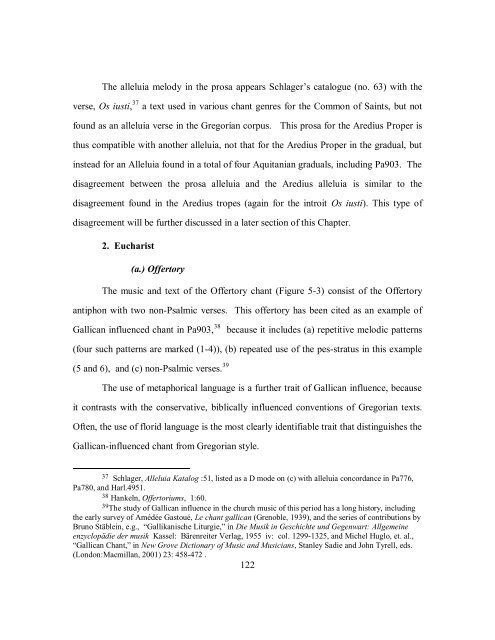Front Matter Template - The University of Texas at Austin
Front Matter Template - The University of Texas at Austin
Front Matter Template - The University of Texas at Austin
Create successful ePaper yourself
Turn your PDF publications into a flip-book with our unique Google optimized e-Paper software.
<strong>The</strong> alleluia melody in the prosa appears Schlager‟s c<strong>at</strong>alogue (no. 63) with the<br />
verse, Os iusti, 37 a text used in various chant genres for the Common <strong>of</strong> Saints, but not<br />
found as an alleluia verse in the Gregorian corpus. This prosa for the Aredius Proper is<br />
thus comp<strong>at</strong>ible with another alleluia, not th<strong>at</strong> for the Aredius Proper in the gradual, but<br />
instead for an Alleluia found in a total <strong>of</strong> four Aquitanian graduals, including Pa903. <strong>The</strong><br />
disagreement between the prosa alleluia and the Aredius alleluia is similar to the<br />
disagreement found in the Aredius tropes (again for the introit Os iusti). This type <strong>of</strong><br />
disagreement will be further discussed in a l<strong>at</strong>er section <strong>of</strong> this Chapter.<br />
2. Eucharist<br />
(a.) Offertory<br />
<strong>The</strong> music and text <strong>of</strong> the Offertory chant (Figure 5-3) consist <strong>of</strong> the Offertory<br />
antiphon with two non-Psalmic verses. This <strong>of</strong>fertory has been cited as an example <strong>of</strong><br />
Gallican influenced chant in Pa903, 38 because it includes (a) repetitive melodic p<strong>at</strong>terns<br />
(four such p<strong>at</strong>terns are marked (1-4)), (b) repe<strong>at</strong>ed use <strong>of</strong> the pes-str<strong>at</strong>us in this example<br />
(5 and 6), and (c) non-Psalmic verses. 39<br />
<strong>The</strong> use <strong>of</strong> metaphorical language is a further trait <strong>of</strong> Gallican influence, because<br />
it contrasts with the conserv<strong>at</strong>ive, biblically influenced conventions <strong>of</strong> Gregorian texts.<br />
Often, the use <strong>of</strong> florid language is the most clearly identifiable trait th<strong>at</strong> distinguishes the<br />
Gallican-influenced chant from Gregorian style.<br />
37 Schlager, Alleluia K<strong>at</strong>alog :51, listed as a D mode on (c) with alleluia concordance in Pa776,<br />
Pa780, and Harl.4951.<br />
38 Hankeln, Offertoriums, 1:60.<br />
39<strong>The</strong> study <strong>of</strong> Gallican influence in the church music <strong>of</strong> this period has a long history, including<br />
the early survey <strong>of</strong> Amédée Gastoué, Le chant gallican (Grenoble, 1939), and the series <strong>of</strong> contributions by<br />
Bruno Stäblein, e.g., “Gallikanische Liturgie,” in Die Musik in Geschichte und Gegenwart: Allgemeine<br />
enzyclopädie der musik Kassel: Bärenreiter Verlag, 1955 iv: col. 1299-1325, and Michel Huglo, et. al.,<br />
“Gallican Chant,” in New Grove Dictionary <strong>of</strong> Music and Musicians, Stanley Sadie and John Tyrell, eds.<br />
(London:Macmillan, 2001) 23: 458-472 .<br />
122

















